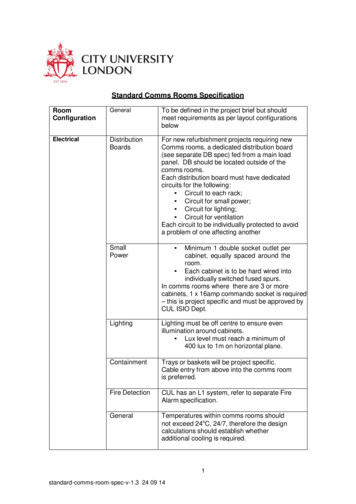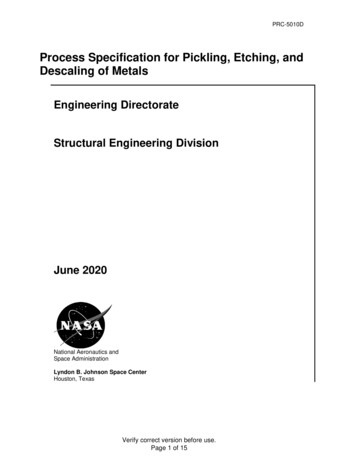
Transcription
PRC-5010DProcess Specification for Pickling, Etching, andDescaling of MetalsEngineering DirectorateStructural Engineering DivisionJune 2020National Aeronautics andSpace AdministrationLyndon B. Johnson Space CenterHouston, TexasVerify correct version before use.Page 1 of 15
PRC-5010DProcess Specification for Pickling, Etching, andDescaling of MetalsPrepared by:Reviewedby:Reviewedby:Approvedby:Signature on FileDaila GonzalezMaterials and ProcessesBranch/ES406/25/2020DateSignature on FileJay BennettMaterials and ProcessesBranch/ES406/26/2020DateSignature on FileJohn FigertMaterials and ProcessesBranch/ES406/26/2020DateSignature on FileBrian MayeauxMaterials and ProcessesBranch/ES406/29/2020DateVerify correct version before use.Page 2 of 15
PRC-5010DProcess Specification for Pickling, Etching, andDescaling of MetalsREVISIONSVERSION--CHANGESDATEOriginal version2/03/00AChanged Division name. Corrected errors in metal removalthickness before penetrant inspection in Sections 3.0 and6.3.2. Re-titled and revised Section 6.1.10/2004BExtensive Changes in sections 6, 7, and 8, associated withthe processing of titanium.12/2004CRetitled Section 4.0 (Applicable Documents) to (References)and updated document titles and numbers. Reformattedtables in Section 6.3 (SpecialRequirements),2/2007DUpdated document title to include descaling of metals; addedstatement to Section 1.0 Scope and Section 6.3.2 Etching forPenetrant Inspection stating electropolishing (PRC 5009) isthe first choice prior to fluorescent penetrant inspection; addedlisting of alloys recommended for electropolishing; updatedpickling, etching, and descaling description in Section 3.0Usage; updated engineering drawing callouts in Section 3.0;added statement to Section 6.3.2 imposing process controlcoupons to verify minimum metal removal when etching priorto fluorescent dye penetrant inspection; added Figure 1 toSection 6.3.3 Descaling to Remove EDM Recast Layer as anexample of a cross sectional view of EDM layers; addedFigures 2-4 to demonstrate descaling effectivity to removeEDM recast layer; updated etching (Section 6.3.2) anddescaling (Section 6.3.3 and 6.3.4) process requirementstables; deleted tensile coupon requirements to verify freedomfrom hydrogen embrittlement from Section 8.1 AdditionalRequirements for Titanium; added Figure 5 to Section 8.1 todemonstrate alpha case discoloration and removal postdescaling on Ti 6-4 surface; updated Section 9.0 Training andCertification of Personnel; updated/added definitions toSection 10 Definitions; minor grammatical corrections.06/2020Verify correct version before use.Page 3 of 15
PRC-5010D1.0SCOPEThis document provides the standard requirements for etching, pickling, and descaling ofmetals by acids or alkali aqueous solutions.It does not address the light pickling of Monel to remove embedded foreign metals, whichis covered by the passivation PRC-5002.Electropolishing is the first choice for pre-fluorescent penetrant inspection for the followingalloys: Austenitic (300 series) Stainless Steels, including 302, 304, 316, 321, 347Precipitation Hardened Stainless Steels, including 15-5PH, 17-4PH, 17-7PHMiscellaneous Stainless Steels, including A-286, Nitronic 60Inconel Alloys, including Inconel 625, Inconel 718Multi-Phase Alloys, including MP35N, MP159Monel Alloys, including Monel 400, Monel R-405, Monel K-500Hastelloy, including C-276Electropolishing may also be used for removing electrical discharge machining (EDM)layers and scale for the above alloys, depending on the application.The process specification for electropolishing corrosion-resistant steel is PRC-5009.2.0APPLICABILITYThis specification shall be applicable whenever a pickling, etching, or descaling is invokedper Section 3.0, “Usage”. It also applies whenever shop procedures that meet thisspecification are invoked by another process specification or shop instruction.3.0USAGEThis specification covers a wide variety of processes and metals, so the engineering drawingcallout shall be specific enough to ensure that the proper work instructions are used.“Pickling” is typically used to describe a process that removes light surface oxides andremoves contamination from surfaces that are oxidized or corroded.“Etching” is typically used to describe a process that removes parent metal in a controlledmanner, sometimes to achieve specific surface textures.“Descaling” is typically used to describe the removal of oxide scale or heavy heat tint causedby heat treating or welding.The following drawing callouts are for standard JSC processes.Verify correct version before use.Page 4 of 15
PRC-5010DStainless SteelsPICKLE TO REMOVE EDM RECAST LAYERS PER NASA/JSC PRC-5010.(including CRES 300 series (except for 303), 15-5PH, and A286)ETCH FOR PENETRANT INSPECTION PER NASA/JSC PRC-5010.(15-5PH only)PICKLE TO REMOVE HEAT TINT PER NASA/JSC PRC-5010.(including CRES 300 series (except for 303), 15-5PH, and A286)Nickel AlloysETCH FOR PENETRANT INSPECTION PER NASA/JSC PRC-5010.(IN718 only)Titanium (6Al4V)DESCALE TO REMOVE EDM RECAST LAYERS PER NASA/JSC PRC-5010. PICKLETO REMOVE HEAT TINT PER NASA/JSC PRC-5010.Aluminum (Most common alloys)DESCALE TO REMOVE EDM RECAST LAYERS PER NASA/JSC PRC-5010 ETCH FORPENETRANT INSPECTION PER NASA/JSC PRC-5010.All new pickling, etching and descaling processes shall be qualified for the alloy at eachfacility performing the processing. Once a process is qualified, the qualification testing doesnot have to be repeated for that alloy if no essential process variables have changed and noprocessing problems are discovered. The details of the qualification shall be recorded in aProcess Qualification Record (PQR) with any limitations of the process so noted. All PQRsshall be stored on the ES Library on DDMS.Pickling, etching and descaling processes for other metals and other purposes can bequalified when necessary, but the designer should consult with the cognizant materialsengineer to ensure that a procedure can be developed and successfully qualified beforemanufacturing needs the process. The remelt zone and heat affected areas caused by EDM(Figure 1, not drawn to scale) can affect fatigue, surface hardness, and other properties. Anexample is 6Al-4V titanium which can form cracks in brittle, oxygen-enriched layers, zonesand phases (alpha case). If these zones and layers are present in EDM processed materials,production coupons may be required and these coupons shall be metallographicallyexamined to ensure complete removal of these detrimental zones and layers.A significant amount of material may be removed during pickling, etching, or descalingprocessing. In most cases, this will be compensated for during machining, but there may besome cases for which dimensional control may be difficult to maintain. The typical maximummetal removal after etching aluminum and titanium for penetrant inspection is .0006 inchesand for stainless and nickel- based alloys are .0004 inches. For parts with tight dimensionalcontrol, the design engineer may choose to add specific drawing notes and/or coordinateclosely with M&P and manufacturing.Verify correct version before use.Page 5 of 15
PRC-5010DA frosted appearance is common on stainless steel and nickel based alloys as a result ofetching.4.0REFERENCESThe following documents were used in developing this specification:SOP-007.1Preparation and Revision of Process SpecificationsJPR 8500.4Engineering Drawing System ManualThe following documents are called out as an extension of the requirements given in thisspecification. All documents listed are assumed to be the current revision unless a specificrevision is listed.ASTM A380Standard Practice for Cleaning, Descaling, and Passivation ofStainless Steel Parts, Equipment, and SystemsASTM B600Descaling and Cleaning Titanium and Titanium AlloySurfaces.NASA/JSC TI-5000-01Metal Finishing Technicians, Training Instruction for5.0MATERIAL REQUIREMENTSNone6.0PROCESS REQUIREMENTS6.1WORK INSTRUCTIONSAll work shall be performed to written procedures. The work instructions shall containsufficient detail to ensure that the manufacturing process produces consistent, repeatableproducts that comply with this specification.For work performed at JSC facilities, these work procedures consist of Detailed ProcessInstructions (DPI’s).For contracted work, the contractor shall be responsible for preparing and maintaining, andcertifying written work procedures that meet the requirements of this specification.6.2GENERAL REQUIREMENTSPickling, etching, and descaling processes shall be controlled to effectively remove oxidationor damage on metal surfaces while minimizing any deleterious effect on the surface. Thesurface finish shall be smooth, without pitting or attack of grain boundaries. For susceptiblemetals, the process should not have a negative effect on the mechanical properties of themetal.General requirements for bath compositions are listed in the sections for each specialVerify correct version before use.Page 6 of 15
PRC-5010Dprocess. The specific compositions and operating parameters of each process shall bedetailed in the work instruction and summarized in the PQR. Work instructions for stainlesssteels and alloys shall be in compliance with the standard practices of ASTM A 380. Workinstructions for titanium alloys shall be in compliance with the standard practices of ASTMB600.Free machining stainless steels shall not be pickled, etched, or descaled.While removing the EDM layers on titanium parts, the surface can become resistant tochemical reaction. If this occurs, the part shall be lightly blasted with abrasives to reactivatethe surface and the part returned to the processing solution. Maximum abrasive sizes are #10for glass bead and 220 grit for alumina and silicon carbide.High temperature caustic solutions may be used to precondition titanium prior to acidtreatments. This treatment may remove all visible scale or oxidation, but a flash pickleafterwards is required at a minimum.Oxygen and nitrogen diffuse into the titanium at high temperatures and form a brittle phasecalled alpha case, which can readily fracture and subsequently initiate several types of serviceor test failures. The visual inspection of titanium parts after pickling or descaling shall includeverification that alpha case has been removed. Visual inspector shall meet the trainingrequirements in section 9.0.6.3SPECIAL REQUIREMENTS6.3.1ETCHING FOR SUBSEQUENT METAL FINISHINGEtching processes used as preparation of metals surfaces for subsequent metal finishingshall use process solutions controlled and qualified by the subsequent metal finishingprocess and its work instructions.6.3.2ETCHING PRIOR TO FLOURESCENT PENETRANT INSPECTIONWhen metal parts are etched for penetrant inspection, a minimum layer of metal must beremoved to meet NDE reliability requirements. For aluminum and titanium, the minimummetal to be removed is 0.0004 inches. For stainless steel and nickel-based alloys, theminimum metal to be removed is 0.0002 inches. Process control coupons shall be used toverify minimum metal removed.Table 1 provides etching process requirements prior to fluorescent penetrant inspection.Verify correct version before use.Page 7 of 15
PRC-5010DTable 1: Etching Process Requirements Prior to Fluorescent Penetrant InspectionAlloyProcess Solution*TemperatureNotes15-5PH50 ml HCl,10g coppersulfate, 50 ml water(Marble’s Reagent)AmbientIN71850 ml sat. aqueouscopper sulfate, 50 ml HClAmbientMonel 400and K500Concentrated nitric acid(colorless)Ambientswab or immerse for3-5 minutesTitanium 6-430 ml nitric acid 3 ml HF67 ml waterAmbientswab or immerse for3-5 minutesAluminumEtch:10 g NaOH, 90 ml waterAmbientswab or immerse for5-15 minutesDesmut:50% nitric acid(2000 & 7000 Series)immerse or swabuntil contrast isobtainedimmerse or swabuntil contrast isobtainedimmerse (under aminute)*Any quantity of etch solution may be prepared provided the ratios in the table aremaintained.6.3.3DESCALING TO REMOVE EDM RECAST LAYERQualification coupons shall be processed that verify that the recast layer will becompletely removed. The EDM cutting schedule used in qualification shall have acutting current (usually denoted as IP) that is the same or higher than the productionparts.Figure 1 shows a cross-sectional view of the EDM layers. The HAZ plus the RemeltZone is often only about 0.0001 inches. The oxidized zone is often about 0.0005inches for stainless and about 0.0020 inches for titanium alloys. The oxidized zonecontains gaps, voids and laps between highly oxidized particles that are partiallyfused to the Remelt Zone layer. This porous, oxidized zone can trap liquids duringsubsequent processing if it is not removed. In addition, this oxidized layer containsbrass particles from the EDM wire.Verify correct version before use.Page 8 of 15
PRC-5010DFigure 1: Electrical Discharge Machining (EDM) LayersTable 2 provides descaling process requirements to remove EDM recast layer.Table 2: Descaling Process Requirements to Remove EDM Recast LayerAlloyProcess SolutionTemperatureNotesStainless SteelsCRES 300 series(except 303), 155PH, A286nitric HF acidAmbientConcentrations perASTM A380TitaniumPickle:nitric acid 20-30ml HFacid 2.0-3.0ml balancewater, to make up100mlAmbient10:1 nitric/HF ratio orgreaterVerify correct version before use.Page 9 of 15
PRC-5010DAluminumphosphoric acid 80%acetic acid 15%nitric acid 5%212 FFigures 2-4 depict EDM surfaces prior to and post descaling on Al 6061 T6, CRES 304,and Ti-6-4.Figure 2: Al 6061 T6 wire EDM surface (left), descaled surface (right).Verify correct version before use.Page 10 of 15
PRC-5010DFigure 3: CRES 304 wire EDM surface (left), descaled surface (right).Figure 4: Ti 6-4 wire EDM surface (left), descaled surface (right).Verify correct version before use.Page 11 of 15
PRC-5010D6.3.4DESCALING TO REMOVE SCALE AND HEAT TINTWhen parts are to be descaled to remove scale or heat tint, the metal parts shall beimmers
ASTM A380 Standard Practice for Cleaning, Descaling, and Passivation of Stainless Steel Parts, Equipment, and Systems ASTM B600 Descaling and Cleaning Titanium and Titanium Alloy Surfaces. NASA/JSC TI-5000-01 Metal Finishing Technicians, Training Instruction for 5.0 MATERIAL REQUIREMENTS None 6.0 PROCESS REQUIREMENTS 6.1 WORK INSTRUCTIONS All work shall
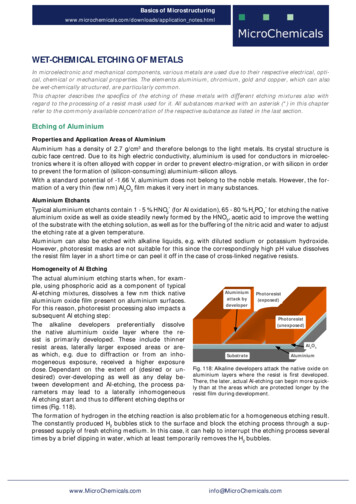
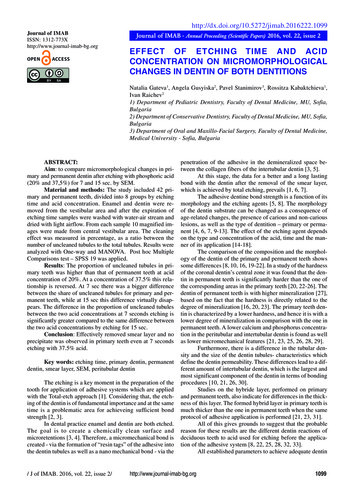
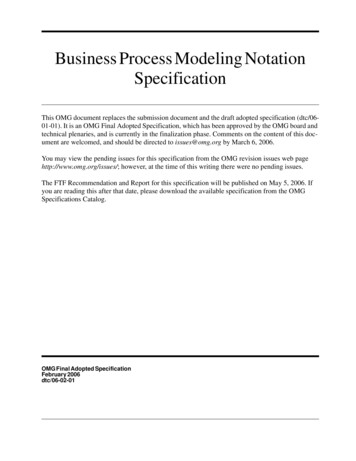
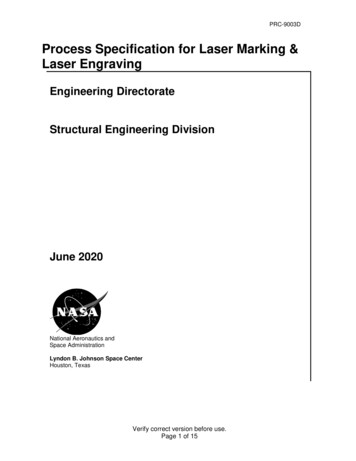
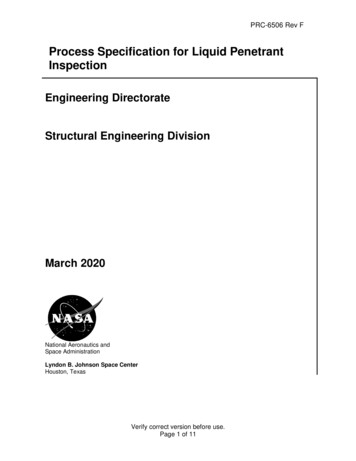
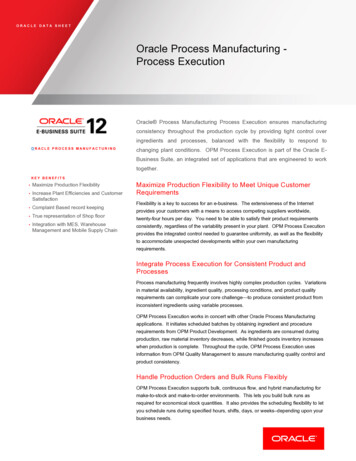
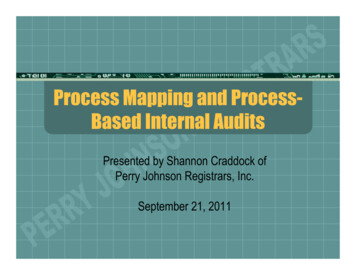



![[MS-ADTS-Diff]: Active Directory Technical Specification](/img/1/ms-adts-170316-diff.jpg)
